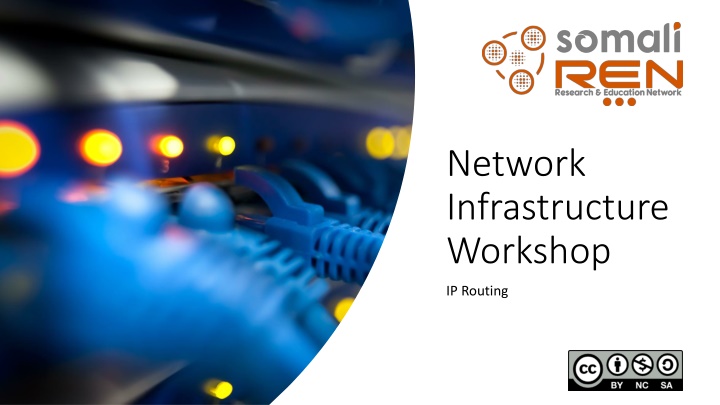
IP Routing Protocols and Routed Protocols
Learn about the differences between routing protocols and routed protocols, how routers use them to navigate networks efficiently, and the importance of routing factors for effective packet delivery in network infrastructure workshops.
Download Presentation

Please find below an Image/Link to download the presentation.
The content on the website is provided AS IS for your information and personal use only. It may not be sold, licensed, or shared on other websites without obtaining consent from the author. If you encounter any issues during the download, it is possible that the publisher has removed the file from their server.
You are allowed to download the files provided on this website for personal or commercial use, subject to the condition that they are used lawfully. All files are the property of their respective owners.
The content on the website is provided AS IS for your information and personal use only. It may not be sold, licensed, or shared on other websites without obtaining consent from the author.
E N D
Presentation Transcript
Network Infrastructure Workshop IP Routing Immagine 7
IP Routing IP routing is basically the process of moving packets from one network to another network using routers.
Do you understand the difference between a routing protocol and a routed protocol?
Routers use routing protocols to dynamically find all networks within the greater internetwork and to ensure that all routers have the same routing table. Routing protocols are also employed to determine the best path a packet should take through an internetwork to get to its destination most efficiently. RIP, RIPv2, EIGRP, and OSPF are great examples of the most common routing protocols. IP Routing
Once all routers know about all networks, a routed protocol can be used to send user data (packets) through the established enterprise. Routed protocols are assigned to an interface and determine the method of packet delivery. Examples of routed protocols are IP and IPv6. IP Routing
The term routing refers to taking a packet from one device and sending it through the internetwork to another device on a different network. Routers don t really care about hosts they only care about networks and the best path to each one of them. The logical network address of the destination host is key to getting packets through a routed network. IP Routing
Heres an important list of the minimum factors a router must know to be able to effectively route packets: Destination address Neighbor routers from which it can learn about remote networks Possible routes to all remote networks The best route to each remote network How to maintain and verify routing information
Static routing is the process that ensues when you manually add routes in each router s routing table. Static Routing
Static Routing ip route [destination_network] [mask] [next-hop_address or exitinterface] [administrative_distance] [permanent] This list describes each command in the string: ip route: The command used to create the static route. destination_network: The network you re placing in the routing table. Mask: The subnet mask being used on the network. next-hop_address: This is the IP address of the next-hop router Exitinterface: Used in place of the next-hop address if you want, and shows up as a directly connected route. administrative_ distance By default, static routes have an administrative distance of 1 or 0 if you use an exit interface instead of a next-hop address. Permanent: Choosing the permanent option keeps the entry in the routing table no matter what happens.
Static Routing R1(config)#do sho ip route S 192.168.10.0/24 [150/0] via 172.16.10.5 172.16.0.0/30 is subnetted, 3 subnets C 172.16.10.4 is directly connected, Serial0/0/1 L 172.16.10.6/32 is directly connected, Serial0/0/1 S 172.16.10.0 [150/0] via 172.16.10.5 C 192.168.20.0/24 is directly connected, FastEthernet0/0 L 192.168.20.1/32 is directly connected, FastEthernet0/0 10.0.0.0/24 is subnetted, 1 subnets S 10.10.10.0 [150/0] via 172.16.10.5
Default Route A stub indicates that the networks in this design have only one way out to reach all other networks, which means that instead of creating multiple static routes, we can just use a single default route. This default route is used by IP to forward any packet with a destination not found in the routing table, which is why it is also called a gateway of last resort.
R1(config)#do sho ip route [output cut] Gateway of last resort is 172.16.10.5 to network 0.0.0.0 172.16.0.0/30 is subnetted, 1 subnets C 172.16.10.4 is directly connected, Serial0/0/1 L 172.16.10.6/32 is directly connected, Serial0/0/1 C 192.168.20.0/24 is directly connected, FastEthernet0/0 L 192.168.20.0/32 is directly connected, FastEthernet0/0 S* 0.0.0.0/0 [1/0] via 172.16.10.5












